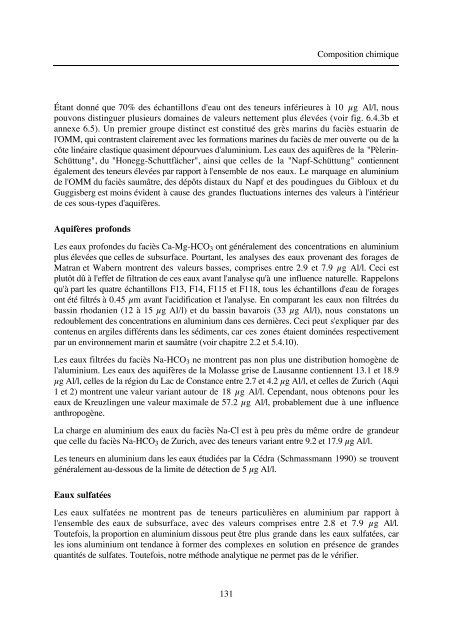typologie des eaux souterraines de la molasse entre chambéry et linz
typologie des eaux souterraines de la molasse entre chambéry et linz
typologie des eaux souterraines de la molasse entre chambéry et linz
You also want an ePaper? Increase the reach of your titles
YUMPU automatically turns print PDFs into web optimized ePapers that Google loves.
131<br />
Composition chimique<br />
Étant donné que 70% <strong><strong>de</strong>s</strong> échantillons d'eau ont <strong><strong>de</strong>s</strong> teneurs inférieures à 10 µg Al/l, nous<br />
pouvons distinguer plusieurs domaines <strong>de</strong> valeurs n<strong>et</strong>tement plus élevées (voir fig. 6.4.3b <strong>et</strong><br />
annexe 6.5). Un premier groupe distinct est constitué <strong><strong>de</strong>s</strong> grès marins du faciès estuarin <strong>de</strong><br />
l'OMM, qui contrastent c<strong>la</strong>irement avec les formations marines du faciès <strong>de</strong> mer ouverte ou <strong>de</strong> <strong>la</strong><br />
côte linéaire c<strong>la</strong>stique quasiment dépourvues d'aluminium. Les <strong>eaux</strong> <strong><strong>de</strong>s</strong> aquifères <strong>de</strong> <strong>la</strong> "Pèlerin-<br />
Schüttung", du "Honegg-Schuttfächer", ainsi que celles <strong>de</strong> <strong>la</strong> "Napf-Schüttung" contiennent<br />
également <strong><strong>de</strong>s</strong> teneurs élevées par rapport à l'ensemble <strong>de</strong> nos <strong>eaux</strong>. Le marquage en aluminium<br />
<strong>de</strong> l'OMM du faciès saumâtre, <strong><strong>de</strong>s</strong> dépôts distaux du Napf <strong>et</strong> <strong><strong>de</strong>s</strong> poudingues du Gibloux <strong>et</strong> du<br />
Guggisberg est moins évi<strong>de</strong>nt à cause <strong><strong>de</strong>s</strong> gran<strong><strong>de</strong>s</strong> fluctuations internes <strong><strong>de</strong>s</strong> valeurs à l'intérieur<br />
<strong>de</strong> ces sous-types d'aquifères.<br />
Aquifères profonds<br />
Les <strong>eaux</strong> profon<strong><strong>de</strong>s</strong> du faciès Ca-Mg-HCO3 ont généralement <strong><strong>de</strong>s</strong> concentrations en aluminium<br />
plus élevées que celles <strong>de</strong> subsurface. Pourtant, les analyses <strong><strong>de</strong>s</strong> <strong>eaux</strong> provenant <strong><strong>de</strong>s</strong> forages <strong>de</strong><br />
Matran <strong>et</strong> Wabern montrent <strong><strong>de</strong>s</strong> valeurs basses, comprises <strong>entre</strong> 2.9 <strong>et</strong> 7.9 µg Al/l. Ceci est<br />
plutôt dû à l'eff<strong>et</strong> <strong>de</strong> filtration <strong>de</strong> ces <strong>eaux</strong> avant l'analyse qu'à une influence naturelle. Rappelons<br />
qu'à part les quatre échantillons F13, F14, F115 <strong>et</strong> F118, tous les échantillons d'eau <strong>de</strong> forages<br />
ont été filtrés à 0.45 µm avant l'acidification <strong>et</strong> l'analyse. En comparant les <strong>eaux</strong> non filtrées du<br />
bassin rhodanien (12 à 15 µg Al/l) <strong>et</strong> du bassin bavarois (33 µg Al/l), nous constatons un<br />
redoublement <strong><strong>de</strong>s</strong> concentrations en aluminium dans ces <strong>de</strong>rnières. Ceci peut s'expliquer par <strong><strong>de</strong>s</strong><br />
contenus en argiles différents dans les sédiments, car ces zones étaient dominées respectivement<br />
par un environnement marin <strong>et</strong> saumâtre (voir chapitre 2.2 <strong>et</strong> 5.4.10).<br />
Les <strong>eaux</strong> filtrées du faciès Na-HCO3 ne montrent pas non plus une distribution homogène <strong>de</strong><br />
l'aluminium. Les <strong>eaux</strong> <strong><strong>de</strong>s</strong> aquifères <strong>de</strong> <strong>la</strong> Mo<strong>la</strong>sse grise <strong>de</strong> Lausanne contiennent 13.1 <strong>et</strong> 18.9<br />
µg Al/l, celles <strong>de</strong> <strong>la</strong> région du Lac <strong>de</strong> Constance <strong>entre</strong> 2.7 <strong>et</strong> 4.2 µg Al/l, <strong>et</strong> celles <strong>de</strong> Zurich (Aqui<br />
1 <strong>et</strong> 2) montrent une valeur variant autour <strong>de</strong> 18 µg Al/l. Cependant, nous obtenons pour les<br />
<strong>eaux</strong> <strong>de</strong> Kreuzlingen une valeur maximale <strong>de</strong> 57.2 µg Al/l, probablement due à une influence<br />
anthropogène.<br />
La charge en aluminium <strong><strong>de</strong>s</strong> <strong>eaux</strong> du faciès Na-Cl est à peu près du même ordre <strong>de</strong> gran<strong>de</strong>ur<br />
que celle du faciès Na-HCO3 <strong>de</strong> Zurich, avec <strong><strong>de</strong>s</strong> teneurs variant <strong>entre</strong> 9.2 <strong>et</strong> 17.9 µg Al/l.<br />
Les teneurs en aluminium dans les <strong>eaux</strong> étudiées par <strong>la</strong> Cédra (Schmassmann 1990) se trouvent<br />
généralement au-<strong><strong>de</strong>s</strong>sous <strong>de</strong> <strong>la</strong> limite <strong>de</strong> détection <strong>de</strong> 5 µg Al/l.<br />
Eaux sulfatées<br />
Les <strong>eaux</strong> sulfatées ne montrent pas <strong>de</strong> teneurs particulières en aluminium par rapport à<br />
l'ensemble <strong><strong>de</strong>s</strong> <strong>eaux</strong> <strong>de</strong> subsurface, avec <strong><strong>de</strong>s</strong> valeurs comprises <strong>entre</strong> 2.8 <strong>et</strong> 7.9 µg Al/l.<br />
Toutefois, <strong>la</strong> proportion en aluminium dissous peut être plus gran<strong>de</strong> dans les <strong>eaux</strong> sulfatées, car<br />
les ions aluminium ont tendance à former <strong><strong>de</strong>s</strong> complexes en solution en présence <strong>de</strong> gran<strong><strong>de</strong>s</strong><br />
quantités <strong>de</strong> sulfates. Toutefois, notre métho<strong>de</strong> analytique ne perm<strong>et</strong> pas <strong>de</strong> le vérifier.

















